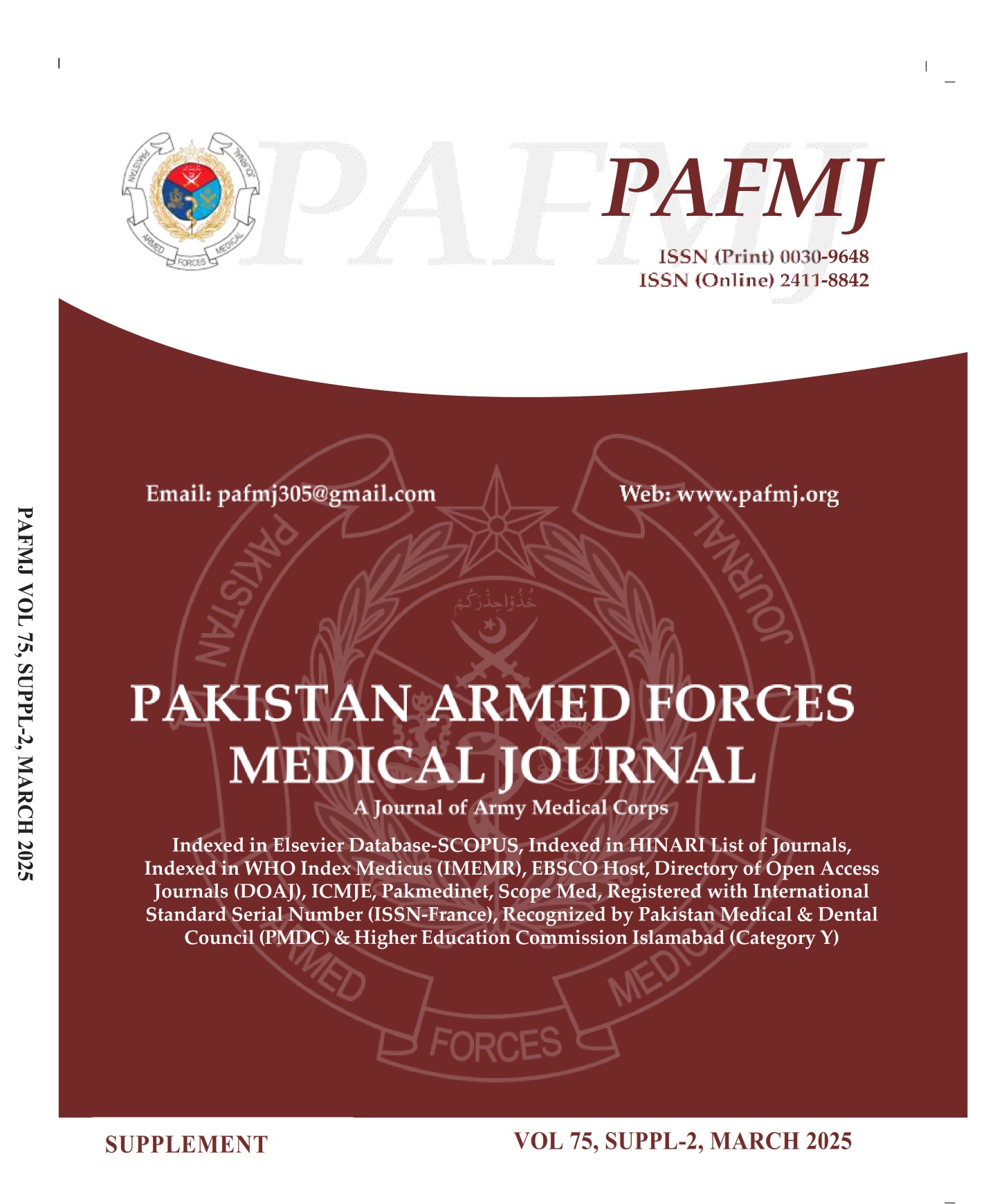Development and Psychometric Properties of Prenatal Obsession Compulsion Scale (POCS)
DOI:
https://doi.org/10.51253/pafmj.v75iSUPPL-2.6582Keywords:
Obsessive Compulsive Disorder, Pregnant Women, Scale DevelopmentAbstract
Objective: To develop an indigenous scale in Urdu language and determine psychometric properties to measure prenatal obsessive compulsive symptoms in pregnant women.
Study Design: Cross sectional analytical study.
Place and Duration of Study: Department of Psychology, University of Gujrat, Pakistan, from Oct 2018 to Sep 2019.
Methodology: Diagnostic criteria of Obsessive Compulsive Disorder present in Diagnostic and Statistical Manual of Mental Disorders-5 and Cognitive Behavior Model of Obsessive Compulsive Disorder were followed to develop the scale. An initial item pool comprising 119 items was generated with the help of extensive literature review, Diagnostic and Statistical Manual-5 and focused group interviews. Expert evaluation limited the item pool to 100 questions. Tryout of scale retained 100 items. Items were re-sequenced and rephrased for final administration. Moreover, data were collected by using self-reported questionnaires from 300 pregnant women, selected by using purposive sampling technique from obstetric and psychiatric wards of different private and government hospitals of district Gujrat. Reliability analysis, exploratory factor analysis and confirmatory factor analysis were implied for data scrutiny.
Results: After final administration of 100 items, 69 items were retained after applying Exploratory Factor Analysis under three sub factors; Obsessions, Compulsions and Impairment of Functioning whereas model fit (p=0.000, CMIN/DF =1.62, CFI=0.934, RMSEA=0.046, SRMR=0.04, GFI=0.834 and TLI=0.93) of Confirmatory Factor Analysis confirmed 40 items for final scale.
Conclusion: Prenatal Obsession Compulsion Scale with 40 items and three subscales is a reliable measure to assess obsessive compulsive symptoms during prenatal period.
Downloads
References
Oran NT, Bilge A, Can HÖ, Kocak YÇ, Demireloz M, Karslioglu S, et al. Influence of prenatal risks of pregnant women on mental symptoms. Anadolu Psikiyatri Derg 2014; 15(2): 157-164. https://doi:10.5455/apd.36328
Çeber E, Bilge A, Mermer G, Yucel U. Risk of postnatal depression and pregnancy in Bornova, İzmir. Turkiye Klinikleri J Gynecol Obst 2010; 20(1): 1-9.
Brok EC, Lok P, Oosterbaan DB, Schene AH, Tendolkar I, van Eijndhoven PF. Infant-related intrusive thoughts of harm in the postpartum period: A critical review. J Clin Psychiatry 2017; 78(8): 913–923. https://doi:10.4088/JCP.16r11083
Lord C, Rieder A, Hall GBC, Soares CN, Steiner M. Piloting the perinatal obsessive compulsive scale (POCS): Development and validation. J Anxiety Disord 2011; 25(8): 1079-1084.
https://doi:10.1016/j.janxdis.2011.07.005
Frías A, Palma C, Barón F, Varela P, Álvarez A, Salvador A. Obsessive compulsive disorder in the perinatal period: Epidemiology, phenomenology, pathogenesis, and treatment. An Psicol 2015; 31(1): 1-7.
https://doi.org/10.6018/analesps.31.1.168511
Collardeau F, Corbyn B, Abramowitz J, Janssen PA, Woody S, Fairbrother N. Maternal unwanted and intrusive thoughts of infant-related harm, obsessive compulsive disorder and depression in the perinatal period: Study protocol. BMC Psychiatry 2019; 19(1): 94-108.
https://doi:10.1186/s12888-019-2067-x
Miller ES, Hoxha D, Wisner KL, Gossett DR. Obsessions and compulsions in postpartum women without obsessive compulsive disorder. J Womens Health 2015; 24(10): 825-830.
https://doi:10.1089/jwh.2014.5063
Dorothy MR. Prevalence and affective outcomes of perinatal obsessive compulsive disorder among clinical attendees in the Capricorn district, Limpopo province [dissertation on the Internet]. University of Limpopo; 2017. Available from:
http://ulspace.ul.ac.za/bitstream/handle/10386/1899/malemela_rd_2017.pdf?sequence=1&isAllowed=y
Kiran T, Shafiq S, Anjum R. Prevalence of prenatal obsessive compulsive symptoms in pregnant women. J Liaquat Uni Med Health Sci 2020; 19(3): 185-190.
Van Broekhoven K, Hartman E, Spek V, Bergink V, van Son M, Karreman A, et al. The pregnancy obsession-compulsion-personality disorder symptom checklist. J Psychol Psychother 2016; 6(1): 233. https://doi:10.4172/2161-0487.1000233
American Psychiatric Association. Diagnostic and statistical manual of mental disorders. 5th ed. Washington, DC: Author; 2013.
Salkovskis PM. Obsessional-compulsive problems: A cognitive-behavioural analysis. Behav Res Ther 1985; 23(5): 571-583. https://doi.org/10.1016/0005-7967(85)90105-6
Akhtar M, Kamal A, Hayee AA, Imtiaz S. Development of a scale to measure reverse culture shock in fresh foreign degree holders. Pak J Psychol Res 2018; 33(1): 257-276. Available from: https://www.researchgate.net/publication/326317159
Netemeyer RG, Bearden WO, Sharma S. Scaling procedures: Issues and applications. London: Sage Publications; 2003.
Pett MA, Lackey NR, Sullivan JJ. Making sense of factor analysis: The use of factor analysis for instrument development in health care research. California: Sage Publications Inc; 2003.
Tabachnick BG, Fidell LS. Using Multivariate Statistics. 5th ed. Needham Heights, MA: Allyn & Bacon; 2007.
Marsh HW, Hocevar D. Application of confirmatory factor analysis to the study of self-concept: First- and higher order factor models and their invariance across groups. Psychol Bull 1985; 97(3): 562–582. https://doi:10.1037/0033-2909.97.3.562
Bentler PM. Comparative fit indexes in structural models. Psychol Bull 1990; 107(2): 238-246. Available from: http://dx.doi.org/10.1037/0033-2909.107.2.238
Kline RB. Principles and practice of structural equation modeling. 4th ed. New York: Guilford publications; 2015.
Hu LT, Bentler PM. Cutoff criteria for fit indexes in covariance structure analysis: Conventional criteria versus new alternatives. Struct Equ Modeling 1999; 6(1): 1-55.
https://doi:10.1080/10705519909540118
Joreskog KG, Sorbom D. Advances in factor analysis and structural equation models. Lanham: Rowman & Littlefield Publishers; 1984.
Tucker LR, Lewis C. A reliability coefficient for maximum likelihood factor analysis. Psychometrika 1973; 38(1): 1-10.
https://doi.org/10.1007/BF02291170
Hair J, Hult GTM, Ringle C, Sarstedt M. A primer on partial least squares structural equation modeling (PLS-SEM). 2nd ed. Los Angeles: SAGE Publications; 2016.
Taber KS. The use of Cronbach’s alpha when developing and reporting research instruments in science education. Res Sci Educ 2017; 48(6): 1273-1296.
https://doi:10.1007/s11165-016-9602-2
Fornell C, Larcker DF. Evaluating structural equation models with unobservable variables and measurement error. J Mark Res 1981; 18(1): 39-50. https://doi:10.1177/002224378101800104
Downloads
Published
Issue
Section
License
Copyright (c) 2025 Tayyeba Kiran, Sameera Shafiq

This work is licensed under a Creative Commons Attribution-NonCommercial 4.0 International License.















